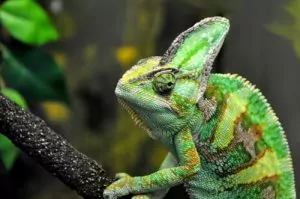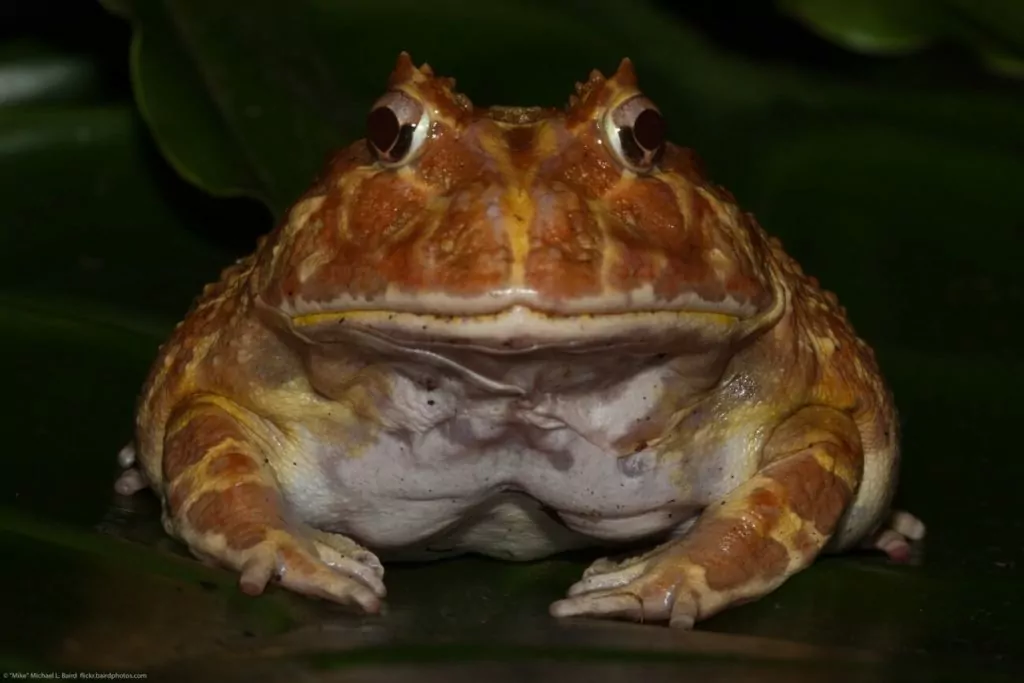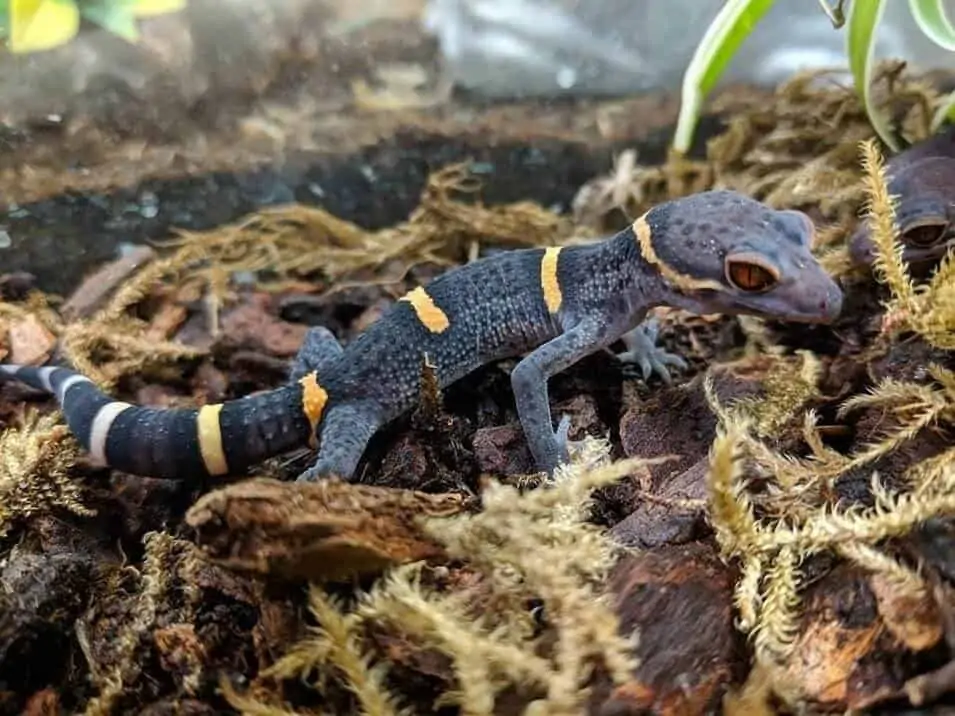The veiled chameleon is one of the most popular pet reptiles out there. These iconic creatures are recognizable by pretty much anyone, and we recommend them all the time.
They’re pretty easy to care for, fun to watch, and generally quite interesting!
But if you’re eager to pick up one of these lizards for yourself, there are a few things you should know ahead of time about their requirements.
In this guide, we’ll cover everything you need to know about veiled chameleon care. You’ll learn about their ideal diet, habitat, potential lifespan, size, and much more!
Table of Contents
Species Summary
The veiled chameleon (Chamaeleo calyptratus) is one of the most popular chameleon species in the world. It’s the creature most people envision when they think of the color-changing reptile. Popularized by movies and television, these chameleons have been a staple in the reptile industry for decades.
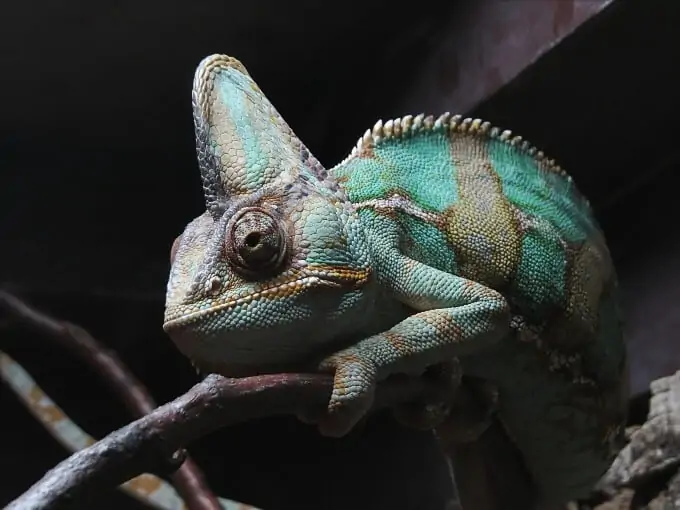
Originally, the veiled chameleon came from the Middle East. They are found in Yemen and Saudi Arabia. For a while, the only way to get these reptiles was to purchase wild-caught specimens. Thankfully, many are captive-bred these days.
Veiled chameleons are considered to be one of the hardiest chameleon species available. Thus, they’re very beginner-friendly. They’re beautiful creatures that certainly make an interesting addition to your pet collection.
Lifespan
The average lifespan of a healthy veiled chameleons is usually at least five years. Males typically have a longer lifespan than females.
Male specimen have been known to live between six and eight years with proper care. Meanwhile, females usually only make it four to six years.
This difference in lifespan is thought to be a byproduct of the female reproductive cycle. Veiled chameleons are a lot like chickens in that they will produce clutches of eggs even if they are not bred. This process takes a toll on the body over time, leading to a dip in life expectancy.
Care Tip: For both males and females, a long life expectancy is not guaranteed. These reptiles are susceptible to many ailments and respond poorly to substandard environments.
If you want your reptiles to live as long as possible, you’ll have to be vigilant about providing them with the best care that you can.
Appearance & Colors
These chameleons are absolute stunners, which is why they are so popular among reptile lovers. Usually, the body is covered in bands of yellow, green, and brown. Of course, that color can change dramatically.
The most defining trait of a veiled chameleon is its ability to change colors on a whim.
They use this behavior in several ways. It can be used to camouflage themselves against natural backdrops whenever they want to hide.
This can also be used to communicate with other creatures. The reptiles are known to flash bright colors in the presence of a potential threat. Some will even change colors when they breed to indicate that they are not receptive!
One cool thing about coloration is that you can use it to gauge your reptile’s health as well. Vibrant jewel tones are usually an indicator that your chameleon is getting all the nutrition they need.
Aside from their bright colors, veiled chameleons have a couple of other quirky physical traits. On the head, you’ll notice that the reptiles have a large horn-like hump. Called the casque, this unique shape helps to divert dripping water into their mouths.
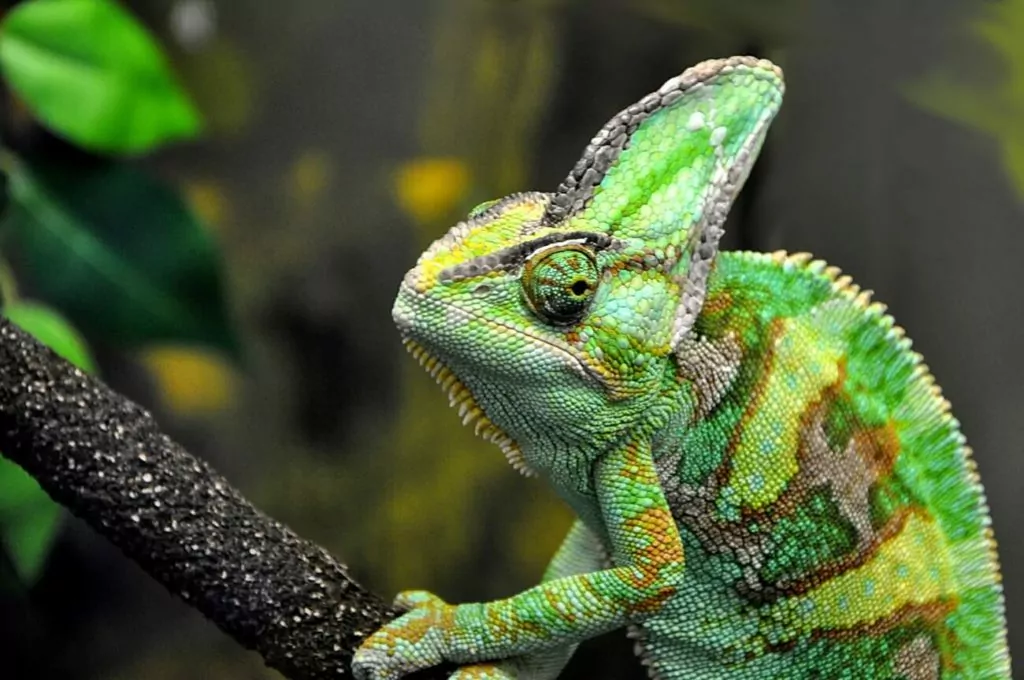
The chameleons have very long tongues, too. They can be twice as long as their overall length. Then, there are the eyes.
The eyes of a veiled chameleon look almost like a turret. They’re conical in shape and can turn almost 180 degrees. Each eye can also move independently, making it easy for the reptile to be wary of their surroundings.
On their feet, you’ll notice that the chameleons have curved toes. The toes help to wrap around tree branches for mobility.
Males and females look very similar at first glance. However, males tend to be a bit larger. The casque on their head is a bit bigger, too. Coloration may be a bit brighter on males as well compared to the females.
Average Size
The average veiled chameleon size is around 18-24 inches for males and 12-18 inches for females. That makes this species one of the largest chameleon breeds out there!
But there’s a catch:
It’s important to note that most of that length actually comes from the tail. These creatures sound massive when you’re only looking at their size on paper, but their tail is actually curled most of the time.
Chameleons use the tail as a stabilizer, often wrapping it around tree branches. Thus, the reptiles aren’t as big as they sound when they’re housed in a well-designed habitat.
Veiled Chameleon Care
While veiled chameleon care is often considered to be beginner-friendly, that doesn’t mean it’s completely hands-off. It’s not uncommon for these reptiles to be abandoned because owners aren’t prepared for the actual work that goes into keeping them healthy.
Abandonment is so common that invasive wild populations have started to pop up in Hawaii and Florida.
These chameleons do require a lot of attention. But, it’s not as difficult as one may think. Once you cover the basics and stick to a routine, you should have no problem keeping this reptile healthy and happy.
Cage Size
The first thing you’ll need to consider is the size of the cage. Bigger is always better for veiled chameleons.
However, it’s not the width of the habitat you need to worry about. It’s the height. Chameleons are big climbers and do best when they have multiple levels they can enjoy.
Adult male veiled chameleons can do fine in a cage size of 24 inches wide, 24 inches long, and 48 inches tall. However, we recommend bumping the width and length measurements up to 36 inches if possible.
Females can do well in slightly smaller tanks. The bare minimum you should get is 18 inches wide, 18 inches long, and 36 inches wide. Of course, you should always get something bigger if you can accommodate it.
Care Tip: Solid glass tanks are not suitable for veiled chameleons. The closed environment could lead to respiratory infections. Plus, the reflections created by the glass could cause stress with the reptiles.
A screened enclosure is most suitable. Mesh cloth that’s coated with PVC is usually regarded as the best choice for veiled chameleons.
Habitat Setup
When many people think of the natural habitat of the Middle East, they think of dry arid climates. While that’s true for some parts, veiled chameleons are found on coastal mountain slopes. The environment experiences a lot of rainfall, resulting in lush vegetation.
The best way to decorate a veiled chameleon habitat is to replicate that natural environment as closely as possible. Let’s start at the bottom of the enclosure.
You can keep the bottom of the enclosure completely bare. Or, you can cover it with coconut fiber or newspaper. If you want something more natural-looking, reptile-approved dirt mixes are good, too.
The one thing you should avoid is any substrate with large chunks.
This means gravel and wood chips are not acceptable. Veiled chameleons have been known to ingest those large pieces, which creates potentially fatal digestive issues.
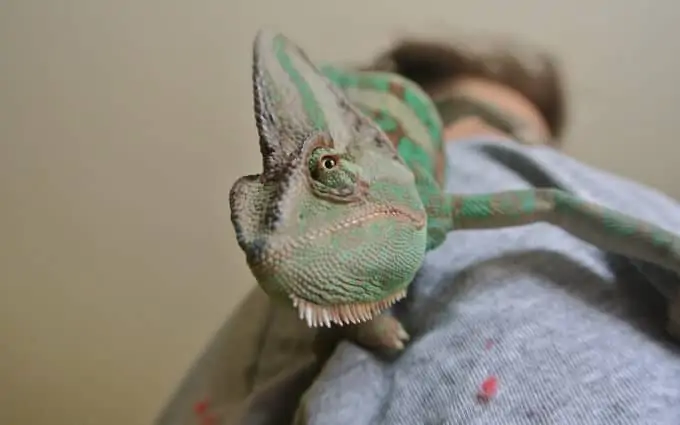
Now, onto decorations.
You should fill the tank with a good mix of fake and real plants. For the fake plants, use plastic. Silk plants will not hold onto water, which is important for veiled chameleons.
The live plants can be comprised of non-toxic varieties. Ficus, Hibiscus, Schefflera, Pothos, and Dracaena, are all popular choices.
Those plants are going to do a lot to improve the environment and help manage humidity levels while also giving your reptile some much-needed coverage.
Plants should be kept on one side of the enclosure. The rest of the tank needs to be relatively open and filled with climbing branches.
As we mentioned earlier, chameleons are big climbers! Use climbing branches and vines of varying sizes to create a nice network of paths for your reptile to explore.
Make sure that all branches are firm, resistant to damage, and safe enough for your chameleon’s delicate feet.
Temperature & Lighting
Veiled chameleons prefer daytime temperatures between 71°F and 82°F. At night, the temperature can drop a bit.
The reptiles are actually fully capable of handling temperatures as down to the upper 40s. However, most owners will utilize a ceramic heater to keep things closer to 70 degrees at night.
Chameleons do not respond to heating rocks as other reptiles do. That heat needs to come from a heating lamp. Lamps should be placed on the mesh top of the enclosure.
To give your chameleon a chance to bask in the heat, place a branch 6 to 8 inches below it. Veiled chameleons regulate their body temperature on their own. By utilizing a light on the top of the enclosure, you’re creating different temperature ranges.
Your chameleon will move throughout the enclosure as they see fit. If they need to cool down a bit, they’ll move down away from the lamp.
Generally, there are two different light source requirements. The first is the heating lamp. The second is a full-spectrum UVB lamp. Both sources should be on for about 12 hours a day.
Care Tip: The UVB lamp ensures that your veiled chameleon can absorb calcium. It’s crucial for avoiding potentially fatal bone diseases!
Water, Hydration, & Humidity
Don’t expect a veiled chameleon to drink from a dish. They won’t show any interest in pools of water. In the wild, they get moisture from the air and drink from droplets that form on leaves.
As a result, you’re going to have to mist the enclosure twice a day.
Cover your plant leaves so that the reptile has plenty of hydration. If you don’t want to worry about regular mistings, you can install an automatic water dripper or misting system.
A misting system is quite effective because it also helps manage humidity levels.
At the very least, veiled chameleons need a moderate humidity level of 50 percent at all times. However, some owners bring that level up to 80 percent.
Remember, this type of chameleon will often get these fluids from breathing in the humid air. Having a higher humidity level only ensures that the reptile is fully hydrated.
Veiled Chameleon Food & Diet
A balanced and varied diet is crucial for veiled chameleons. In the wild, these creatures will often feed on plant leaves and insects that happen to fly by.
The most popular food for these animals is crickets, and these insects can serve as a staple of their diet. However, those crickets need to be gut loaded. This is important because it negates the high phosphorus levels of the insect.
To gut load your crickets, simply feed them high-calcium foods like spinach before serving them up as meals for your chameleon.
In addition to crickets, you can add some variety with earthworms, mealworms, and waxworms. Vegetables are good too. You can provide collard greens, mustard greens, and lettuce.
Calcium supplements and vitamins are essential as well. You can purchase supplement powders and brush feeder crickets with calcium a few times a week. Vitamine dusting isn’t as frequent. It’s only needed once every other week.
Care Tip: Veiled chameleons don’t need to be fed every day as adults. Juveniles will need daily feedings to supplement their growth cycle. But adults do best when they are fed every other day.
Potential Health Issues
Unfortunately, these animals are susceptible to a wide range of health problems.
The good news is that most of those issues are directly related to stress and a poorly maintained environment. This means by staying on top of the habitat and practicing good veiled chameleon care, you should be able to avoid major problems.
As we mentioned earlier, veiled chameleons are at risk for nutrient deficiencies and bone disease. Metabolic Bone Disease is caused by a lack of calcium in the diet. It often leads to bone fractures, lethargy, and other injuries. Make sure to provide supplements and utilize a UVB lamp to avoid this!
Infections are common as well. Respiratory infections, eye infections, and mouth infections are usually caused by poor humidity levels or contaminated water.
Those conditions can be treated by improving the quality of the habitat. A vet may also provide antibiotics to prevent any lasting damage.
Behavior & Temperament
For the most part, veiled chameleons are docile creatures that don’t show much activity. When they aren’t eating, they tend to move slowly and will spend their day basking in the heat. You might see the reptile climbing around the enclosure as they regulate their body temperature.
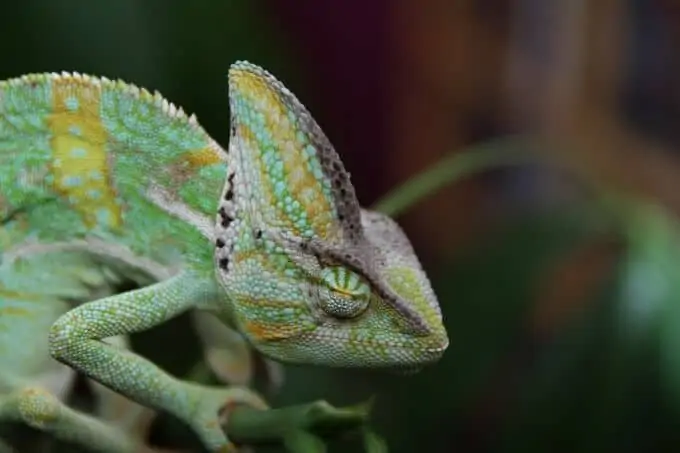
Interestingly enough, veiled chameleons can get a bit aggressive. Adult chameleons should not be kept together in groups. They do best when they live alone.
This is especially true with males. Male veiled chameleons have been known to get stressed merely at the sight of another male! That’s why avoiding reflections in their habitat is so important!
Handling Them
Despite what television and movies would have you believe, veiled chameleons aren’t the biggest fans of getting held.
They are considered to be a pet that you should watch rather than hold regularly. You can hold them every once in a while, but doing it too much may cause unnecessary stress.
When you do need to handle these reptiles, be gentle. They cannot regenerate parts of their body like some other species!
Moving slowly, position one hand under the upper half of the body. Then, use the other handle to gently uncoil the tail from the branch. Use your fingers to unlatch their feet and they should grasp onto your hand for stability.
Don’t be forceful and pull the lizard from the branch! This can upset these creatures and even cause a potentially serious injury.
Breeding
After about a year of life, veiled chameleons are fully mature and ready for breeding. Introduce the two chameleons slowly and keep a watchful eye on them. Aggression is possible.
If the female wants to breed, she will let the male approach and do so. They may breed a few times before the female decides she’s had enough. At that point, she’ll usually turn a darker color as a sign for the male.
You can then separate the male and female. Over the next month, the eggs will gestate in the female’s body. When she’s ready to lay them, you can observe her looking for a spot. You’ll need to create a separate environment for her to lay the eggs.
This is very easy and can be done with a 5-gallon bucket! Just fill the bucket with about eight inches of a sand and peat mixture. Moisten the mixture a bit so that it holds its shape.
Place the female into the bucket and she will dig a tunnel to lay the eggs. Once she emerges, you can remove her and put her back in her habitat. The eggs can be removed immediately and placed into a sealed container with vermiculite and water.
The eggs will incubate at room temperature. Just place the container in a dark spot. The eggs will hatch anywhere between 5 and 10 months!
Now You’re Ready To Go!
Now that you’ve learned the fundamentals of veiled chameleon care, you’re ready to get one for yourself!
These interesting creatures are a bunch of fun to own, and quite rewarding to keep. We know highly experienced owners who always keep a spot in their home for this species (no matter what other exotic reptiles they own).
If you have any lingering questions about veiled chameleons we’d be more than happy to chat with you. We always enjoy hearing from a fellow herp-lover!

